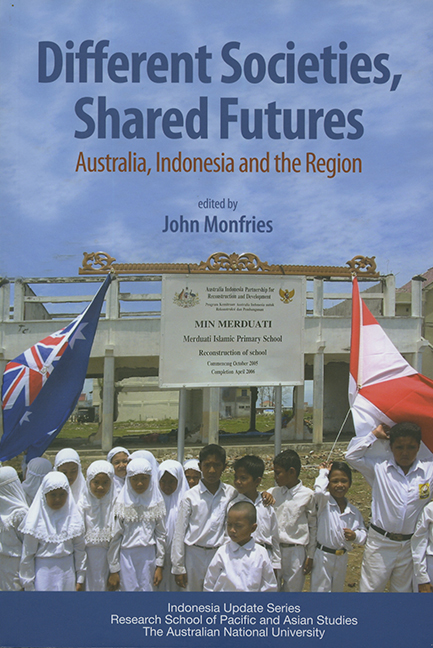Book contents
- Frontmatter
- Dedication
- Contents
- Tables
- Figures
- Contributors
- Acknowledgments
- Opening Address by Richard Woolcott AC
- 1 Introduction
- PART I Regional Viewpoints
- PART II Security Aspects
- PART III Mutual Perceptions and Irritations
- 7 Strange, Suspicious Packages
- 8 The Indonesian Student Market to Australia: Trends and Challenges
- 9 The Centrality of the Periphery: Australia, Indonesia and Papua
- PART IV The Economic Partnership: Aid, Economics and Business
- PART V Conclusion
- Glossary
- References
- Index
9 - The Centrality of the Periphery: Australia, Indonesia and Papua
from PART III - Mutual Perceptions and Irritations
Published online by Cambridge University Press: 21 October 2015
- Frontmatter
- Dedication
- Contents
- Tables
- Figures
- Contributors
- Acknowledgments
- Opening Address by Richard Woolcott AC
- 1 Introduction
- PART I Regional Viewpoints
- PART II Security Aspects
- PART III Mutual Perceptions and Irritations
- 7 Strange, Suspicious Packages
- 8 The Indonesian Student Market to Australia: Trends and Challenges
- 9 The Centrality of the Periphery: Australia, Indonesia and Papua
- PART IV The Economic Partnership: Aid, Economics and Business
- PART V Conclusion
- Glossary
- References
- Index
Summary
In the roller-coaster ride that has been the history of the bilateral relationship between Australia and Indonesia, regions of the eastern archipelago, particularly East Timor and Papua, have been issues of particular sensitivity and have at times even dominated the relationship. Strategic interest in the regions closest to Australian territory and perceptions about the eastern archipelago's cultural diversity and governance have been among Australian concerns, while suspicions about Australia's interests and intentions in the archipelago, especially after the international intervention in East Timor in 1999, remain at the forefront of Indonesia's concerns. There are elements of Australian government thinking of the 1950s and early 1960s, and some sections of current public opinion, that question the legitimacy of the Indonesian state in the culturally diverse parts of the eastern archipelago. Sir Wilfred Kent Hughes, one-time minister in the Menzies government, provided an ill-informed but influential example of this attitude when he wrote in the Melbourne Herald in 1950:
The inhabitants of New Guinea are foreigners as far as the Indonesians are concerned. They belong almost entirely to the frizzy-haired families of mankind. Indonesians are straight-haired (Kent Hughes 1950).
Sir Wilfred asserted that neither historically nor racially had New Guinea ever been part of Indonesia.
Informed in part by attitudes not too dissimilar to those of Kent Hughes, Australia supported a continued Netherlands administration in Papua until 1962. In January of that year, when diplomatic tensions between Indonesia and the Netherlands seemed likely to spill over into military conflict, the minister for external affairs, Sir Garfield Barwick, persuaded the Menzies government that Australia's interests would be best served by a close and cooperative relationship with a united Indonesia. Barwick argued that it was not in Australia's interest to support an independent Papua, as foreshadowed by the Dutch. He said that such a state would be small, unviable, indefensible and the focus of Indonesian antagonism. The Australian government may have been embarrassed and uncomfortable with the manner in which Indonesia conducted the 1969 ‘Act of Free Choice’, but the outcome – Papua's incorporation into Indonesia – was consistent with the strategic decision it made in 1962. The logic of the policy pursued by Australian governments since 1962 is that Australia has an interest in Indonesia successfully accommodating Papua and convincing Papuans that their preferred future should be as part of Indonesia.
- Type
- Chapter
- Information
- Different Societies, Shared FuturesAustralia, Indonesia and the Region, pp. 106 - 126Publisher: ISEAS–Yusof Ishak InstitutePrint publication year: 2006



